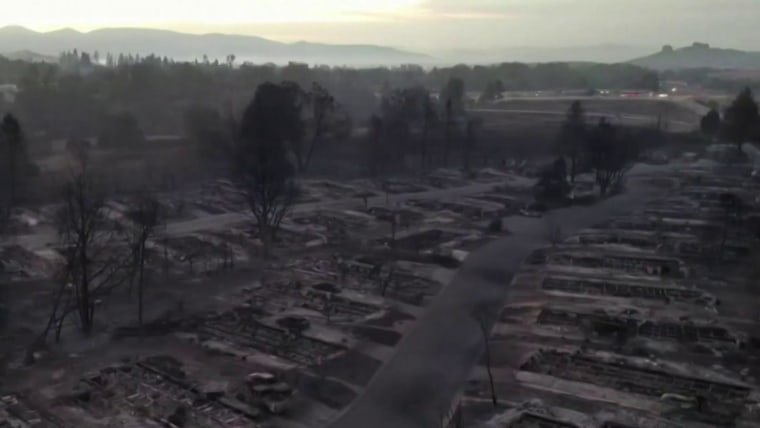Power outages hamper evacuation warnings and distance learning in wildfire-torn
Danielle Mays lives in a wood cabin at the end of a 10-mile dirt road near Feather Falls, California. On Tuesday afternoon, Mays, a music teacher, saw smoke from the approaching North Complex West Zone fire, and knew something was wrong.
But Mays had no power, and thus no reliable cell phone service, so she hadn’t received any emergency alert to warn her of the dangerous fire. In fact, she had no Wi-Fi or even water, because her cabin and 70 acres rely on a well. In an effort to prevent more wildfires from igniting, California’s largest utility provider, Pacific Gas & Electric (PG&E) had intentionally shut off power the previous night to Mays and more than 150,000 other customers across 22 counties in Northern California.
The North Complex West Zone fire has already killed 10 people and burned more than 70,000 acres in Butte County. The fire was caused by lightning more than a month ago, but is still just 5 percent contained.
Mays scoured the Butte County Sheriff and California Department of Forestry and Fire Protection (Cal Fire) websites as best she could with her limited reception. “It was two hours past the evacuation order before I could even see the [evacuation] map on my phone,” Mays told NBC News.
She and her roommate gathered up her most prized musical instruments and furnishings, plus two dogs and three chickens, and loaded as much as they could fit in the car.
“As I walked away from the house, I thought, ‘that house is kindling.’ Even the inside is solid wood paneling. It’s a matchstick house,” explained Mays, who is still evacuated and doesn’t know if her beloved cabin has been consumed by the fire or not.
“I totally understand why PG&E has to turn the power off with those high winds. I get it. But there has to be some consideration for the fact that we all need to keep the water going and cell phone reception.”
In a press release, PG&E said it uses “Public Safety Power Shutoffs” (PSPS) “only as the last resort to protect community and customer safety against wildfires, given dry and windy weather, dry vegetation and an elevated fire risk across portions of its service area.” The utility says that wind gusts of up to 66 miles per hour were recorded during the PSPS and that there were dozens of incidents of damage that could have caused wildfire ignitions, including downed power lines.
But, as California residents contend with the coronavirus pandemic and resulting distance learning on top of deadly wildfires, for many, the timing of the outage couldn’t have been worse.
School districts across the state had to scramble to come up with a way to keep virtual learning going despite the planned outages. In Rincon Valley Union School District, which includes the fire-torn city of Santa Rosa, Assistant Superintendent Mike Herfurth said teachers spent their Labor Day planning for virtual schooling with no power across five campuses. “They had to work on Monday, a holiday, to email all the families and let them know what assignments to do over the next two days since they wouldn’t have access to email” or be able to teach virtually on Tuesday or Wednesday.
“There’s already such a huge learning curve for teachers, students, and parents just on distance learning — and to have the power outage thrown into that, it was a big effect,” Herfurth said. “We are completely having to reinvent how we are doing distance learning.”
In all, more than 2,000 students in the district weren’t able to participate in live instruction due to the planned PG&E power outages.
Bernadette Calhoun teaches high school math at Healdsburg High School, and has been conducting her classes on Zoom since March. Last month, the explosive Walbridge Fire threatened the entire town of Healdsburg — the town was evacuated and school was canceled for days. So, when she learned she, too, would lose power in the PSPS on Tuesday, she thought, “‘These kids didn’t have school for days. And now, this. I just can’t upend their lives again.’ I just decided to figure out how best to teach them.”
That meant finding another location with internet for her to teach classes: in her case, Calhoun’s 80-year-old mother’s house in Sonoma. “But I didn’t want to go inside [because of the risk of coronavirus], so I just sat on the porch to use the Wi-Fi.”
Unfortunately, on Wednesday, Sonoma’s skies were also darkened because of wildfire smoke, even in the middle of the day — to the point that street lamps remained illuminated and cars had to drive with headlights on.
As Calhoun sat outside on the porch, maskless and teaching her high schoolers from her laptop, “it was dark and raining ash in Sonoma. It was hard, and I ended up with a headache. I can still feel it in my sinuses today,” she said by phone on Thursday.
“You can’t quit, so you just keep doing the best you can,” Calhoun said….
Read More: Power outages hamper evacuation warnings and distance learning in wildfire-torn


